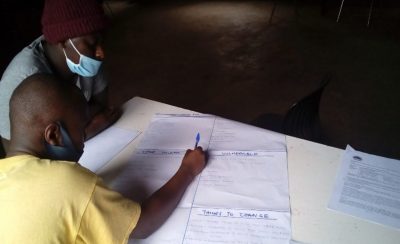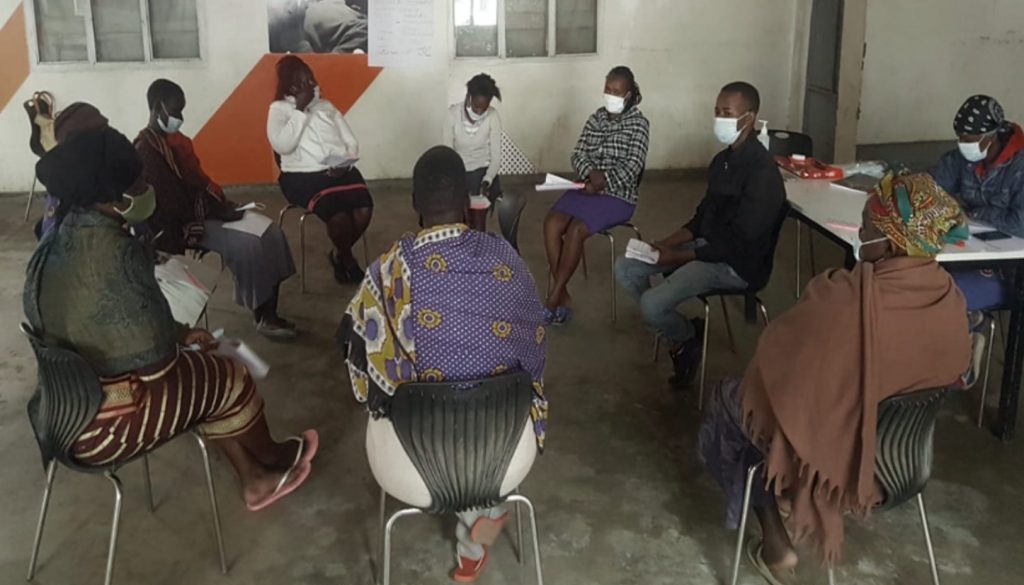Social mapping in Nairobi
In the second blog in this series, our co-researchers (John Mutinda, Lydia Akwabi, Judith Achieng, Famuel Omwaka, Daniel Obiero, and Joel Mburu) explain the social mapping exercise they embarked on as part of the social and governance terrain study. They were supported by researchers (Caroline Kabaria, Ivy Chumo and Blessing Mberu).

The social mapping exercise was the second part of the mapping social and governance terrain study we embarked on as co-researchers. Following on from the community profiling work we did, it was an equally informative activity involving participants from different social groups representing all the villages in the community. As part of the exercise, a social map/chart is prepared by the community to depict social aspects, and describes what local people believe to be relevant and of importance.
In our social mapping activity, we aimed to understand the social aspects of study communities where the ARISE project has been implemented. The activity entailed mapping/charting six themes: stakeholders, influential groups, marginalised groups, vulnerable groups, social structures, and things one would change if they had power.
In the stakeholders’ section, study participants discussed community stakeholders, and for the influential section, they discussed actors with influence in the community from the lowest influence, to the highest. They also discussed and ranked the marginalised and vulnerable groups in the community from the most marginalised/vulnerable to the least, and finally concluded by listing the things they would change if they had the power starting from the most important to the least.
Next participants took part in a focus group discussion (FGD). We subdivided the participants into two groups during the charting activity before engaging them as one group in a focus group discussion. During the charting, we would guide each of the two groups (one co-researcher in each group) on mapping.

Each group would select a moderator and a secretary and agree on ground rules. Our role was to continuously monitor and guide the groups without influencing their thoughts and ensuring every person was inv
olved in the activity. During the FGDs, one of us would participate as a moderator and another one as a note-taker in the morning and the roles would be reversed in the afternoon. Many community participants said this exercise felt like classwork, as it involved putting thought into what they recorded as a group, but admitted that it was a thought-provoking exercise on things they usually don’t usually think about, particularly the social structures and influential groups.
As with our previous social mapping activity, we ensured that the venue adhered to COVID-19 guidelines. Study participants who arrived late to the venue were quiet and reluctant to contribute to the discussions, our mitigation was to briefly re-consent and explain to them the purpose of the study. Face masks and social distancing affected some participants’ audibility while responding to questions and we asked one to either project their voice or pull down the mask when speaking and pull it up once done talking. A few respondents were dominant in the discussions, and we would guide them politely to allow others to speak.
We scheduled two groups each day; one for female participants and the other for male participants.
This was a community-led activity. Some participants took time debating the ranking for influential, marginalized or vulnerable groups. In many instances, they asked us not to intervene and let them decide on their own. We only gave our guidance where needed and made clarifications where possible. We noticed that some respondents were not participating in the discussion, and we encouraged them to participate and explained the value of their inputs to the final output. Outputs differed based on social group dynamics in the community. For instance, marginalized and vulnerable groups varied from group to group, but people with disability, older persons and child headed households were common. During the focus group discussion we learned that the community had solutions to many of the of the social challenges identified, they just need direction on how to begin.
 Every challenge has an opportunity for learning hence we learned a lot from these activities. We learned about social structures, influence, actors, power, marginalized and vulnerable groups in the community during social mapping. Having been raised in the communities, we understood how social structures and influence impacts community profiles mapped in earlier sessions. In addition, we learned how to conduct FGDs and the importance of mastering the content to avoid asking a wrong kind of questions, receiving incorrect responses, thereby compromising the quality of the data collected. Probing was also an important quality of a moderator, allowing them to collect as much information as possible. We learned that patience was a key skill for moderators and note takers, giving participants time to express themselves fully. Being part of this study was a privilege. We are confident that we are well-positioned to understand the community better and be a change to our communities.
Every challenge has an opportunity for learning hence we learned a lot from these activities. We learned about social structures, influence, actors, power, marginalized and vulnerable groups in the community during social mapping. Having been raised in the communities, we understood how social structures and influence impacts community profiles mapped in earlier sessions. In addition, we learned how to conduct FGDs and the importance of mastering the content to avoid asking a wrong kind of questions, receiving incorrect responses, thereby compromising the quality of the data collected. Probing was also an important quality of a moderator, allowing them to collect as much information as possible. We learned that patience was a key skill for moderators and note takers, giving participants time to express themselves fully. Being part of this study was a privilege. We are confident that we are well-positioned to understand the community better and be a change to our communities.
